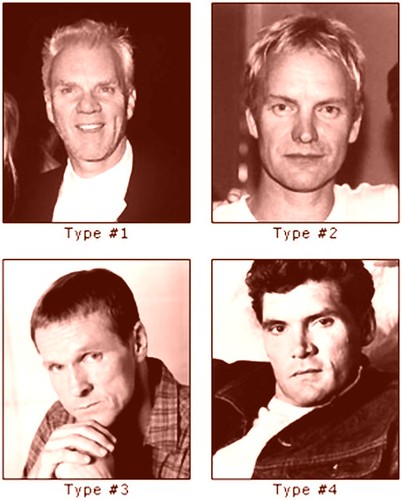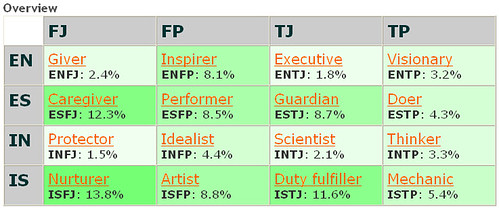More fun with Myers-Briggs
15 Jun 2006I’ve been reading quitea lot on Myers-Briggs for my previous post “Myers-Briggs typology“, and some of it is too good not to post it here, so here is my second MBTI post! I’ve also made an new MBTI web tool for my web tools collection, that you can use to quickly check the facts for each type.
MBTI at first sight?
Get this: according to socionics, it is possible to do Visual Identification (V.I.) of the Myers-Briggs type. They prove it by showing 4 pictures (Malcolm McDowell, Sting, and two familiar actors-I-can’t-name) with -granted- similar features, and they’re all ISTJ (Sting a duty fulfiller?). I’ll be honest, I don’t buy this. I know that you can sometimes guess character traits from someone’s face (e.g. a ‘kind’ face vs. a ‘hard’ face), and I can understand how your physical attributes (pretty/ugly, thin/chubby) might influence your behaviour and consequently your MBTI type, but I’m not sure this method would withstand a critical scientific eye.

You’re a dyslexic INFJ? What are the odds?

The population is not evenly distributed over the 16 subtypes, some are more common than others. According to statistics from wikipedia, the most common types are ISFJ (13.8%), ESFJ (12.3%) and ISTJ (11.6%). The least common categories are INFJ (1.5%), ENTJ (1.8%) and INTJ (2.1%). Since the most prominent ISFJ only differs by 1 character from the least occurring INFJ, one could speculate that the ‘N’ (Intuitive) component does not match well with the ‘I’ (Introvert), ‘F’ (Feeling) and/or ‘J’ (Judging). My guess is that a ‘J’ normally goes together with an ‘S’ (Sensing), which makes the INFJ a weird combo (looking at the other N/J stats, this works out). This actually means that the 2nd and 4th criterium are *gasp* correlated.
Also interesting, not every person likes to talk about his Myers-Briggs label. I’ve done a quick Google count for each of the types. A high number can mean: people of type X like to talk about themselves, or X is a type that is talked about a lot by people in general. So the reason can be vanity or (in-)sanity. The low hitcount types are ESFJ (107K hits), ISFP (146K) and ENFJ (156K). At the other side we find the popular topics of: INTP (588K), INTJ (724K) and -get ready- ISTP (1.190K). The reason for this last number might be that there is contamination from the likes of “Institut Supérieur des Techniques Productiques” and the “International Solar Terrestrial Physics” NASA program. I don’t see why the ‘Mechanic’ type would enjoy so much more interest.
I’d marry you, but you’re an ISTJ
This Myers-Briggs system gives an new angle to the whole boy-meets-girl thing too! Imagine you’re an ENFP (‘Inspirer’), like me. Can you just shack up with anybody? Nope! Any girl from my complete opposite, ISTJ or ‘Duty fulfiller’, is obviously a no-go: we would have a ‘conflicting‘ relationship (you can read the details, but for now: it’s bad). But that’s not all: with ENFJ (Giver) I’d have a quasi-identical relationship: major misunderstanding. If I were to have dinner with e.g. Claudia, that’s something I’d have to watch out for (and also not eat spaghetti with a white shirt). If you’re not easily pleased (which I’m not), then ENTJ, ESFJ, INTJ, ISFJ, INFP and INTP are also out of the question. Which basically leaves me with the ISTP (Mechanic), ESTP (Doer) and INFJ (Scientist), or only something like 12% of the total population. Add to that requirements for intelligence, humour and some aesthetic considerations -oh, and the girl being single- and one can see how celibate can be such a hard condition to solve. Check out the logic on these inter-type relations on this quasi-mathematical page. Of course, if you believe a different opinion, I’d have to be looking out for INTJ and INFJ. Oh well …
If you want to ‘find your type’ (in whatever meaning), use my MBTI tool.